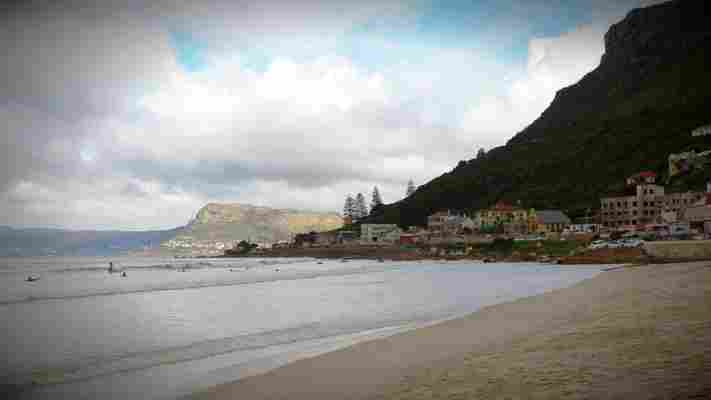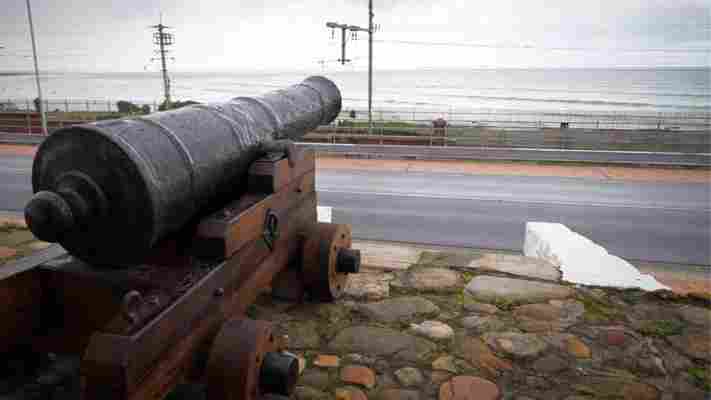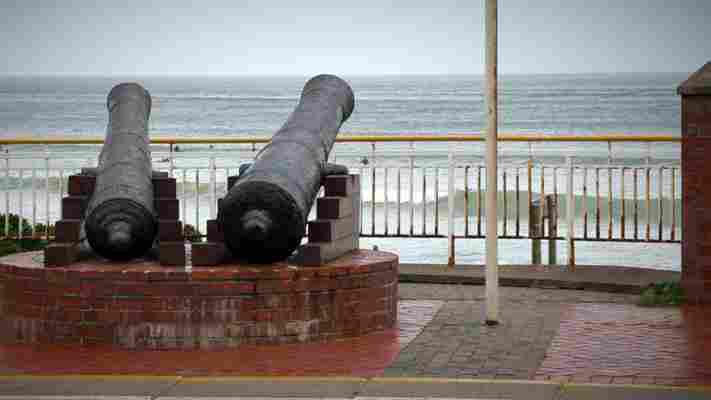

(Credit: Werner Hoffmann)
Crowned by a magnificent flat-topped massif that cascades into the sea, Cape Town’s dramatic setting and strategic position at the crossroads of two oceans has enticed anyone who has ever sailed near Africa’s southern tip. Admired by the Portuguese and British, the Dutch were the first Europeans to establish a port here for the Dutch East India Company in 1652 – and they soon set up a series of coastal gun batteries around the Cape Peninsula in hopes of keeping other Europeans out.
It didn’t work. By the turn of the 18th Century, the British had arrived, hoping to secure the settlement before the French showed up. As the British colonised the Cape, they installed a vast network of artillery defence stations around the coast. Most of these colonial relics were thought to have vanished long ago – until a surprise discovery last year revealed something unexpected underneath a swimming pool.

(Credit: Werner Hoffmann)
According to Cape Town archaeology and heritage specialist Tim Hart, “never was the Cape’s defences so furiously strengthened than during a short-lived and pretty obscure historical event in 1885.” At the time, Hart explained, Britain ruled India, Russia occupied territory in Afghanistan nearby and both countries were worried that the other wanted to extend its control throughout Central Asia. This tension briefly brought Britain and Russia to the brink of war, and Britain feared Russian aggression in India would threaten all of its colonies – including South Africa. When the British military heard that Russia might send warships to South Africa, the British installed modern breech-loading cannons around the Cape, including three huge and mysterious ‘disappearing guns’.
“What made disappearing guns unique was their ability to hide from enemy fire by lowering themselves into a gun pit,” Hart said. “These guns were fitted with hydraulic lifting mechanisms for the artillery crew to lift the barrel from its loading position under a protective shield into a firing position and rotate it towards the target. After it fired, it would disappear back into a vault under a protective shield. These were extremely rare military mechanisms and great examples of mid-Victorian engineering.”
(Credit: ACO Associates CC)
Disappearing guns are considered to be a uniquely British feat of military engineering, and Hart’s research has found very few of these cannon-sized ‘guns’ were used worldwide. According to documents found in the Western Cape Archives and Records Service , at least three disappearing guns were brought to the Cape from England. The New South Wales State Heritage Register mentions 10 of these mountings deployed in Australia, but according to Hart, almost all of these have been demolished. Only parts of one disappearing gun from Cape Town’s Fort Wynyard military base are known to still exist. The rest, as Hart explained, simply vanished.
In early 2018, Hart was called to a building site in the upmarket Cape Town neighbourhood of Sea Point. A construction worker had been demolishing the swimming pool at an old bed and breakfast with a digger when he discovered pieces of iron, armour plating and a large circular gun pit.
(Credit: Werner Hoffmann)
There was no electricity involved in turning these massive structures. The entire system was operated by gears and hand-wheels, while the self-lowering mechanism was powered by the weapon’s recoil. They were true marvels and a testimony to Victorian mechanical ingenuity,” said Hart.
(Credit: Werner Hoffmann)
Hart said the discovery of the disappearing gun isn’t just further evidence of Cape Town’s importance and strategic position throughout its tangled colonial history, but also a reminder of the little-known late 19th-Century power struggle between Russia and Britain. What military archaeologists now realise, said Hart, is that this event sparked an urgent operation to “[rapidly] strengthen and radically modernise” the Cape Peninsula’s coastal gun emplacements and defence systems.
Because of the hardness of the clay on the slopes of Signal Hill in Sea Point, excavating the site was a real challenge. “There were numerous nooks and difficult-to-access areas deep within the workings of the gun mount, which had to be cleared without any mechanical assistance,” Hart said. “But the end result was beyond all expectation.”
Based on military records Hart studied, he knew that the gun barrel had been removed in 1913. “But by and large, the rest of the substantial mechanism for training the gun and elevating the weapon in and out of its protective shield had survived along with most of the gun pit, niches for munitions and firing tubes.” At the entrance to the ammunition port magazine, surviving paintwork gave this mysterious military site a name: the battery had been known as Alpha 1.
(Credit: Werner Hoffmann)
Because of the rarity of disappearing guns worldwide and the good state of the site’s preservation, Alpha 1 is recognised as a Grade 2 national heritage site , meaning it enriches the understanding of South Africa’s cultural, historical, social and scientific development.
Hart said there is a growing interest in military archaeology among Cape Town’s residents and tourists to the Cape Peninsula, with sites such as the nearby Lion Battery , now being visited by an increasing number of people. For this reason, the developers who discovered the site have now agreed to preserve Alpha 1 in its original location as a museum available to the public.
Plans for the museum, which developers hope to open in early 2020, include suspending parts of the gun’s original blast shield from the ceiling. Hart and his colleague, Gail Euston-Brown, will also help create information plaques with archival images and drawings to provide context about the site’s historical importance.
(Credit: Werner Hoffmann)
A mere 800m from where Cape Town’s disappearing gun was discovered, the city’s noon guns – appropriately named, as the cannons fire at 12:00 each day – are a daily reminder to both Capetonians and visitors of the city’s fiery history of defending its strategic coastline. From the Lion Battery on Signal Hill, overlooking Cape Town’s harbour, a loud blast from one of two black powder cannons echoes across Table Bay, often catching tourists unaware. The firing of the noon gun is a tradition dating back to 1806.
The two guns – each 18lb smoothbore muzzle-loaders – were cast in 1794 by Walker & Company in Sheffield, England, and brought to the Cape a year later when the British occupied the Cape Colony after a short battle with Dutch forces in the nearby town of Muizenberg on False Bay. The noon guns on Signal Hill and the disappearing gun that was mounted just below the hill share an important characteristic: they used black gun powder as a propellant. The transition from black gun powder to cordite with its more stable explosive properties in the early 20th Century almost certainly played a role in most disappearing guns in the world being made redundant and thus being phased out, said Hart.
(Credit: Werner Hoffmann)
The disappearing gun at Sea Point Battery never saw military action. During the early years of the 20th Century, the City of Cape Town started to allow property developments very close to the disappearing gun emplacement on the slopes of Signal Hill. The gun was fired once a month as per army regulation. It was not popular among the residents of Sea Point and the nearby Three Anchor Bay. “Apparently it was quite a menace,” said Hart. “The concussions broke a lot of crockery in Sea Point, upset the neighbours, made the dogs bark and so forth. There were a lot of complaints and eventually it was found to be inappropriate that it should be here.”
Eventually, the land was sold by the Department of Defence for a property development known as Battery Estate. It is during this time, shortly after 1920, that the unique emplacement must have been covered over by residential buildings. “The Anglo-Russian threat was long forgotten and the disappearing gun simply disappeared from common historical memory.”
Now, nearly 100 years later, the disappearing gun’s reappearance is a reminder of South Africa’s tangled colonial past, and a British war with Russia that never was.

Leave a Reply